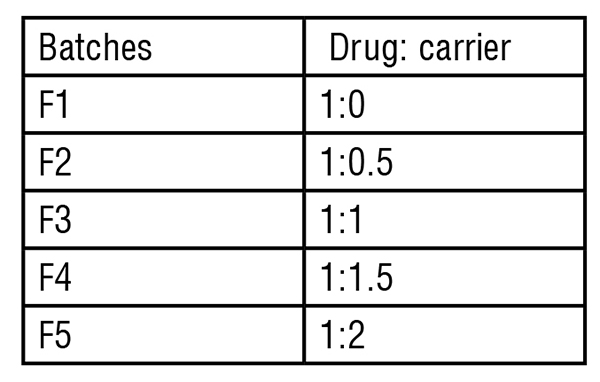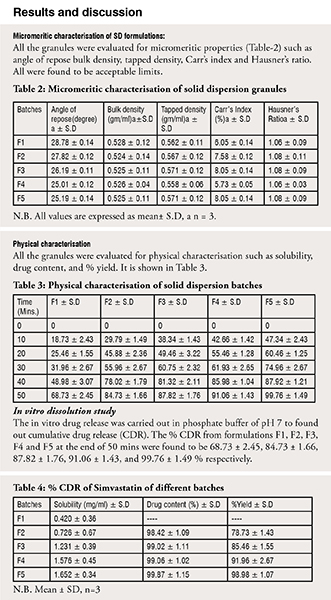Simvastatin is an inhibitor of 3-hydroxy-3-methylglutarylcoenzyme A (HMG-CoA) reductase. It catalyses the conversion of HMG-CoA to mevalonate, an early and ratelimiting step in the biosynthesis of cholesterol. Simvastatin belongs to BCS class II drug. To overcome this shortcoming, a solid dispersion is prepared using a carrier of PEG 6000 to potentially enhance the dissolution rate and extend drug absorption. The objective of the study is to increase the solubility by solid dispersion method and to compare dissolution of pure drug and solid dispersions. The present study is an attempt to enhance the solubility of Simvastatin by fusion (Melt) method using polyethylene glycol 6000 as carrier. The complex of Simvastatin with polyethylene glycol 6000 shows enhanced solubility than the pure drug in the ratio between drug: carrier is 1:2. The dissolution rate studies were performed in phosphate buffer pH 7 and the dissolution rate was found to be 99.94 ± 2.17 per cent for optimised formulation F5 at the end of 50 mins. It is concluded that dissolution of the Simvastatin could be improved by the solid dispersion and PEG 6000 based solid dispersions were more effective in enhancing the dissolution.
Solubility is an important physicochemical factor affecting absorption of drug and its therapeutic effectiveness. The poor aqueous solubility of drugs is still now a challenge in formulation and development. Due to the poor aqueous solubility, the dissolution as well as bioavailability decrease which may be insufficient. Bioavailability of poor water solubility drugs that undergo dissolution rate limited gastrointestinal absorption can generally be improved by formulation techniques, such as preparation of solid dispersions. Solid dispersion, in which compounds are dispersed into water-soluble carriers, has been generally used to improve the dissolution properties and the bioavailability of drugs that are poorly soluble in water. In the biopharmaceutical classification system (BCS) drugs with low aqueous solubility and high membrane permeability are categorised as Class II drugs. Therefore, solid dispersion technologies are particularly promising for improving the oral absorption and bioavailability of BCS Class II drugs. Drugs disperse in the matrix generally a hydrophilic matrix and a hydrophobic drug to form a solid dispersion. The carrier of solid dispersion dissolves in water very quickly. The drug release is high due to more surface area of particles which causes high bioavailability of poor water-soluble drugs. Polyethylene glycols (PEGs) with molecular weights of 1,500–20,000 are extensively used as water-soluble carriers for preparation of solid dispersions of many poorly water-soluble drugs. The carriers show low melting point, rapid solidification rate, low toxicity, low costs, and good solubility in water and most of organic solvents. The aim of a present study was to compare solubility of Simvastatin alone, complexes of aspirin with PEG 6000 using solid dispersion technique.
Materials
Simvastatin was obtained from Researchlab fine chem. Industries India. PEG 6000 was purchased from S D fine-chem limited India. Methanol from SD finechem limited was used. All reagents were of A.R. grade. Double distilled water was used throughout the experiment.
Methods
Preparation of solid dispersion
Melting method was used for the preparation of solid dispersion. Accurately weighed carrier (PEG 6000) was melted in a water bath at 70ºC, the drug was added in the solid state and the mixture stirred until homogeneity was obtained. The mixture was then cooled rapidly in a freezing mixture of ice and stored in a desiccator for 24 hours. Subsequently, the dispersion was grinded in a mortar and sieved through 80 #. The required drug to carrier ratio for formulations was shown in table 1.

Characterisation of solid dispersions Micromeritic characterisation
Angle of repose:
Fixed funnel method determines angle of repose. The required quantity of granules was taken in funnel where funnel tip touched the granules heap. The granules were permitted to fall through the funnel. Powder cone radius was determined and followed by determination of angle of repose using given equation.


Where ϴ is the angle of repose, h is the height of cone in cm and r is the radius of the cone base in cm.
Bulk density (еb):
Bulk density apparatus (Sisco, India) was used to determine bulk density of granules. First granules mass (m) and bulk volume (Vb) was noted. The given equation was used to calculate bulk density.

Tapped density (еt):
Bulk density apparatus (Sisco, India) was used to determine tapped density of granules using standard procedure. First granules mass (m) and tapped volume (Vt) was noted. From the given equation 4 tapped density was calculated

Compressibility index (Carr’s index):
Carr’s index is used to estimate powder flow characteristics. The Carr’s index can be calculated by the following equation 5.

Where et is the tapped density of granules and eb is bulk density of granules
Hausner’s ratio:
Hausner’s ratio is another parameter to estimate powder flow characteristics. It is the ratio of tapped density to bulk density. It is shown in equation 6.

Physical characterisation
Solubility studies
To evaluate the solubility of Simvastatin in the presence and absence of carriers, saturation solubility measurements were conducted. An excess amount of plain Simvastatin and dispersion powder were added to 20 ml of freshly prepared phosphate buffer pH 7 containing 0.5% Sodium lauryl Sulphate (SLS) in clean vials with continuous shaking at 25 ± 0.5ºC for 24 hours to achieve equilibrium. The filtered solutions were suitably diluted and analysed for Simvastatin at 247 nm on a UV spectrophotometer (Shimadzu, model no. 1800 , Japan). Drug content
The drug content in each solid dispersions and physical mixture was determined by the UV spectroscopic method. The simvastatin solid dispersions were prepared and tested for drug contained. From each batch of solid dispersion (prepared in different ratios) equivalent to 10 mg of simvastatin were taken and analysed by proposed method for drug content. Percentage Yield
To determine the efficiency of solid dispersion production percentage yield was calculated. In this method preweighed solid dispersions were collected to determine practical yield. The percentage yield can be calculated using the given equation 7.

In vitro dissolution study
Dissolution studies were performed in phosphate buffer pH 7 containing 900 ml at 37 ± 0.5°C, using USP type-II apparatus with paddle rotating at 75 rpm. Sample of pure drug, solid dispersions of various batches each containing 40 mg equivalent of drug were subjected to dissolution. Aliquots of 5 ml were withdrawn at time intervals of 10, 20, 30, 40, and 50 mins. were filtered and spectrophotometrically analysed at 247 nm.
Accelerated stability study
Stability study was conducted on optimised formulation. The formulations were packed in an airtight container and stored in stability chamber at 40 ± 2°C and 75 ± 5% RH for a period of 3 months. The samples were then withdrawn at interval of 30, 60 and 90 days and were evaluated for drug content and In-vitro dissolution studies.

Conclusion
The solubility and dissolution studies showed there is a possibility of improved solubility of Simvastatin through solid dispersion with PEG 6000 by fusion method. A maximum increase in dissolution rate was obtained with Simvastatin in F5 due high concentration of carrier. Finally, it is concluded that solid dispersion of Simvastatin using hydrophilic polymers improved the solubility, dissolution rate and thereby enhancing its systemic availability.
References:
1. Patil RM, Maniyar AH, Kale MT, Akarte AP and Baviskar DT: Solid dispersion: strategy to enhance solubility. International Journal of Pharmaceutical Sciences Review and Research 2011; 8(2) : 66-73.
2. Dau K and Sharma VK: Solid dispersion technology. Pharmabizj 2009; 10, 1-2.
3. Kamalakkannan V, Puratchikody A, Masilamani K and Senthilnathan B: Solubility enhancement of poorly soluble drugs by solid dispersion technique – A review. Journal of Pharmacy Research 2010; 3: 2314-2321.
4. Leuner C, Dressman J. Improving drug solubility for oral delivery using solid dispersions. Eur J Pharm Biopharm 2000; 50:47‐60.
5. Galia E, Nicolaides E, Horter D, Lobenberg R, Reppas C,Dressman B. Evaluation of various dissolution media for predicting in vivo performance of class I and II drugs. Pharm Res 1998; 15:698‐705.
6. Damian F, Blaton N, Naesens L, Balzarini J, Kinget R, Augustijns P and Van Den Mooter G: Physicochemical characterization of solid dispersions of the antiviral agent UC-781 with polyethylene glycol 6000 and Gelucire 44/14. European Journal of Pharmaceutical Sciences 2000; 10(4): 311-22
7. Joshi H et al. Bioavailability enhancement of poorly watersoluble drug by solid dispersion in polyethylene glycolpolysorbate 80 mixture. Int J Pharm 2004; 269:251‐258.
8. Sahoo CK, Mishra AK, Panda N, Venkataramana D. Enhancement of the Solubility of Midazolam Using Solid Dispersion Technique by Carrier Peg 4000. 2019; 13(2):13-16.
9. Rohan R. Shirsat,Sheeja Koliyote. Evaluation of enhancement of solubility of aspirin by solid dispersion techniques using different polymers concentration, World Journal of Pharmaceutical Research, 2014; 4(1):925-937
10. Sukanya M, Sai Kishore V. Design and Development of Solid Dispersions of Simvastatin for Enhancing the Solubility, Am. J. PharmTech Res. 2012; 2(4): 733-740.
11. Saquib Hasnain M et al., Solubility and dissolution enhancement of ibuprofen by solid dispersion technique using PEG 6000-PVP K 30 combination carrier, Chemistry: Bulgarian Journal of Science Education, 2012; 21(1): 118-132.